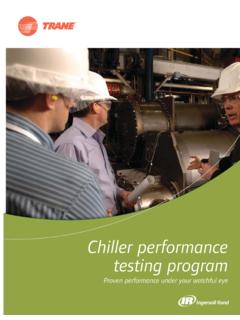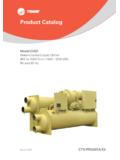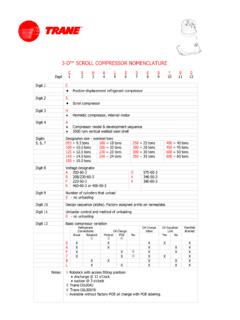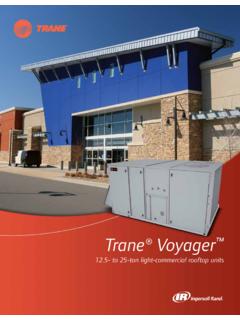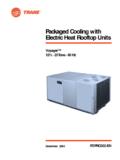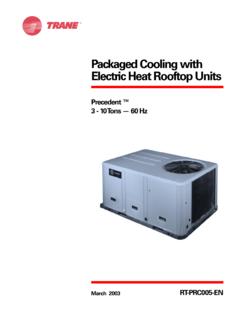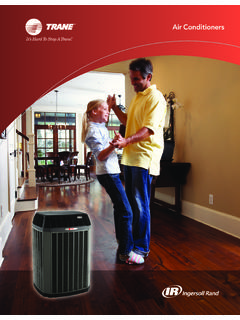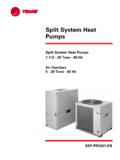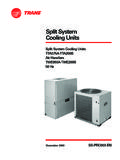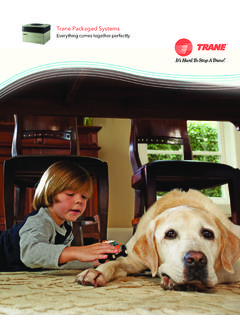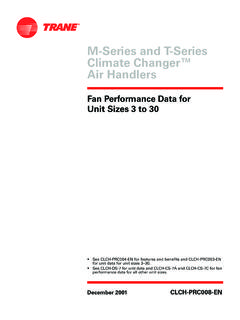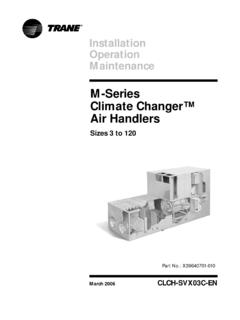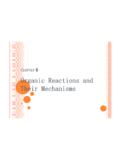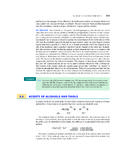Transcription of CDQ™ Desiccant Dehumidification - Trane
1 CDQ Desiccant DehumidificationCool Dry QuietNovember 2010 clch -PRB020-ENEngineering Bulletin 2010 Trane All rights reserved clch -PRB020-ENTable of ContentsFeatures and Benefits .. 4 Moisture Management in Buildings .. 4 CDQ System Concept .. 5 Overview of Desiccants .. 6 Energy Wheels .. 7 Active Desiccant Wheels .. 8 CDQ Desiccant Wheel .. 9 CDQ System Performance .. 10A Basic CDQ Air Handler Example .. 10 CDQ System - The Benefits .. 12 CDQ Performance Data .. 13 Typical Achievable Dew Point .. 13 Latent Capacity .. 16 Pressure Loss .. 17 CDQ Air Handler Configurations .. 18 Preheat .. 18 Location of Outside Air Inlet .. 20 Location of Supply Fan .. 21 Filtration Requirements .. 22 Location of Heating Coils .. 22 Combining Exhaust-Air Energy Recovery with a CDQ Wheel .. 22 Dedicated Outdoor-Air Systems and a CDQ Wheel.
2 23A CDQ System vs. Active Desiccant Systems .. 23 CDQ Applications .. 2435 to 45 Percent Relative Humidity Spaces .. 24 Dry Storage/Archives .. 24 Hospital Operating Rooms .. 24 Laboratories .. 2550 to 65 Percent Relative Humidity Spaces .. 25 Schools and Colleges .. 25 Retail Stores and Restaurants .. 25 Office Buildings .. 25 Equipment Selection .. 26 Outside Air Conditions .. 26 Sizing Cooling Equipment .. 26 Sizing Preheat .. 26 Sample Selections .. 26 clch -PRB020-EN3 Example: 35 percent RH limit application, dry storage .. 29 Wheel Construction .. 31 Drive System .. 31 Wheel Media .. 31 Wheel Life .. 314 clch -PRB020-ENFeatures and BenefitsTrane Cool Dry Quiet (CDQ ) wheels can greatly improve the Dehumidification capabilities of an air conditioning system. CDQ system features and benefits include: Increased cooling coil latent ( Dehumidification ) capacity.
3 Lower achievable supply-air dew point. Decreased need for reheat. Lower unit cooling sensible heat ratios. Warmer required chilled water temperatures. Improved energy efficiency for Dehumidification . Decreased required cooling capacity when dehumidifying. Eliminates exhaust air as a Management in BuildingsPreventing moisture-related problems in buildings and in HVAC systems is a shared responsibility among all parties involved in building design, specification, construction, commissioning, maintenance, and use. Managing building moisture involves many components and it is important to realize that the HVAC system alone cannot prevent all moisture-related problems, such as: Building envelope design and construction (including the location of vapor barriers) Flashing installation Roof maintenance Quickly repairing leaks Proper cleaning techniquesFor more information, refer to the Trane Managing Building Moisture application engineering manual (SYS-AM-15).
4 One component of moisture control is to limit indoor humidity. When properly designed and controlled, an HVAC system can provide effective Dehumidification over a wide range of conditions. The Trane application engineering manual Dehumidification in HVAC Systems (SYS-APM004-EN) discusses the challenges of dehumidifying, especially at part-load conditions, and presents several ways to improve the Dehumidification performance of commonly-used HVAC engineering bulletin explains the Trane CDQ Desiccant Dehumidification system and how it can be used to greatly improve the Dehumidification performance of an HVAC :Please be advised that final design and application decisions are your responsibility. Trane disclaims any responsibility for such System ConceptThe Trane CDQ Desiccant wheel is used to enhance the Dehumidification performance of a traditional cooling coil.
5 The wheel is configured in series with the coil (see Figure 1) such that the regeneration side of the wheel is located upstream of the coil and the process side of the wheel is located downstream of the coil. The CDQ Desiccant wheel adsorbs water vapor from the air downstream of the cooling coil and then adds it back into the air upstream of the coil where the coil removes it through condensation. This process is accomplished without the need for a second regeneration air addition of the CDQ Desiccant wheel to the system enhances the Dehumidification performance of the traditional cooling coil. The CDQ wheel transfers water vapor, and the cooling coil does all the Dehumidification work in the system. The latent ( Dehumidification ) capacity of the cooling coil increases without increasing its total cooling capacity. The system can achieve a lower supply-air dew point without lowering the coil temperature.
6 Unlike a system with a cooling coil alone, the dew point of the air leaving the system can be lower than the coil surface temperature. Figure 1. CDQ Dehumidification processesProcess componentsCDQ Desiccant wheelCooling coilFanLeavingregenerationairEnteringair LeavingairLeavingcoolingcoil airCondensateWater vaporHumidity during the CDQ processStage of processAdsorptionCondensationEntering airLeavingregenerationLeavingcooling coilLeaving airHumidity levelRegeneration6 clch -PRB020-ENOverview of DesiccantsDesiccants are substances specially designed to attract water vapor from the air. The water vapor is transferred from the air to the Desiccant through the process of adsorption. Adsorption occurs at the molecular level; water vapor molecules are adsorbed into the Desiccant . Adsorbents are micro-porous materials that do not change phase when they exchange water vapor.
7 Examples of adsorbents are activated aluminas, silica gels, and molecular sieves (zeolites). This is different than absorbents, which change phase during this exchange of water vapor. Examples of absorbents are hygroscopic salts, such as lithium chloride. Absorbents are more subject to chemical change and are often in liquid can vary greatly. Most people are unaware that there are hundreds of variations of silica gels, molecular sieves, and activated aluminas; each is designed and manufactured for a specific task. These different desiccants can be further categorized based on their ability to hold water vapor at a specific temperature and relative humidity. This characteristic curve is called the Desiccant isotherm. The typical isotherms of the three basic categories of desiccants (Types I, II, and III) are shown in Figure 2. Example of Desiccant isotherms5045403530252015105002040608010 0 Type IIIT ypical Sorption Isothermsfor Various Desiccants at 75 FWeight % Water Vapor% Relative HumidityType IIType ICLCH-PRB020-EN7 Overview of DesiccantsEnergy WheelsTotal-energy wheels (also called enthalpy wheels) are used to transfer both sensible heat and moisture (latent heat) between the outdoor air stream and the exhaust air stream (see Figure 3).
8 Most total-energy wheels use a Type I or Type II Desiccant . The Desiccant wheel rotates quickly between 20 and 60 rotations per minute through the outdoor and exhaust air streams. When it is hot and humid outdoors, sensible heat and moisture are transferred from the outdoor air to the exhaust air stream, cooling and dehumidifying the entering outdoor air. When it is cold and dry outdoors, sensible heat and moisture are transferred from the exhaust air to the outdoor air stream, heating and humidifying the entering air. Total-energy wheels can significantly reduce the ventilation cooling and heating loads, especially at peak conditions, but they do not dehumidify the space. Theoretically, an energy wheel can only be 100 percent effective. The outdoor air leaving the wheel can only get as dry as the exhaust air entering side. The exhaust air comes from the space.
9 Thus, at best, the outdoor air leaving the wheel can only get as dry as the space, but no drier. If supply air is no drier than the space, it cannot dehumidify the space. The system still requires a cooling coil to dehumidify the 3. Total energy recovery wheelsEA (Exhaust air)RA (Return air)Energy wheelOA (Outside air)OA8 clch -PRB020-ENOverview of DesiccantsActive Desiccant WheelsActive (heat-regenerated) Desiccant wheels use a Type II Desiccant . As the sample isotherm in Figure 2 shows, these desiccants can hold a significant amount of moisture even when the air stream is very dry. This is useful when you are trying to make dry air even drier. Type II desiccants are typically used in industrial and pharmaceutical applications where a dew point of 0 F or lower is total-energy wheels, active Desiccant wheels use two separate air streams (see Figure 4).
10 The second regeneration air stream may be the exhaust air stream or a second outside air stream. A heat source is used to warm up the air entering the regeneration side of the wheel. Adding heat to the regeneration air allows the wheel to remove more water vapor from the air passing through the process side of the wheel. The source of heat is usually a direct-fired gas burner or stream heat because the regeneration air must be very hot in order to dry out the process air. Depending on the required dew point of the process air, regeneration air temperatures typically range from 150 F to 300 F. The warmer the regeneration air (OA ) is, the drier the resulting process air (OA ) will total-energy wheels, however, active Desiccant wheels rotate very slowly between 10 and 30 rotations per hour. An active Desiccant wheel is very effective at removing moisture from the supply (process) air stream, but for every ton of latent heat (moisture) removed, it adds more than one ton of sensible heat back into the supply air.
